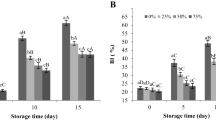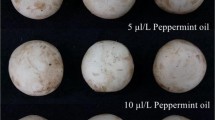Abstract
Postharvest browning is the primary cause of a decrease in the shelf life of the white button mushroom (Agaricus bisporus). This study investigated the effect of postharvest brassinolide (BL) treatment on metabolism in relation to browning of the white button mushroom. Each harvested mushroom was dipped into one of three solutions containing 0, 1, or 3 μM BL for 5 min and stored in darkness at 4 °C for 16 days. Our results indicated that treatment with BL restrains browning development and reduces the total phenolic content and polyphenol oxidase activity. In addition, BL treatment maintains lower weight loss, electrolyte leakage, and malondialdehyde content and inhibits any increase in lipoxygenase activity compared with those of the control mushrooms. Furthermore, BL treatment significantly decreases the accumulation of reactive oxygen species (ROS) and induces the antioxidant enzyme system. Compared with 1 μM BL, treatment with 3 μM BL is more effective in reducing cap browning. The reduction of membrane oxidative damage and ROS levels induced by BL inhibits enzymatic browning reaction in the white button mushroom. These findings suggest that treatment with BL could have the potential of inhibiting browning and thus maintaining the mushroom’s commercial value.




Similar content being viewed by others
References
Aebi, H. (1984). Catalase in vitro. Methods in Enzymology, 105, 121–126.
Aghdam, M. S., & Mohammadkhani, N. (2014). Enhancement of chilling stress tolerance of tomato fruit by postharvest brassinolide treatment. Food and Bioprocess Technology, 7(3), 909–914.
Anantheswaran, R. C., Roy, S., & Beelman, R. B. (1996). Modified atmosphere and modified humidity packaging of fresh mushrooms. Journal of Food Science, 61(2), 391–397.
Bajguz, A., & Hayat, S. (2009). Effects of brassinosteroids on the plant responses to environmental stresses. Plant Physiology and Biochemistry, 47(1), 1–8.
Bradford, M. M. (1976). A rapid and sensitive method for the quantitation of microgram quantities of protein utilizing the principle of protein-dye binding. Analytical Biochemistry, 72(1-2), 248–254.
Brennan, M. H., Le Port, G., & Gormley, R. (2000). Postharvest treatment with citric acid or hydrogen peroxide to extent the shelf life of fresh sliced mushrooms. LWT- Food Science and Technology, 33(4), 285–289.
Chomkitichai, W., Chumyam, A., Rachtanapun, P., Uthaibutra, J., & Saengnil, K. (2014). Reduction of reactive oxygen species production and membrane damage during storage of ‘Daw’ longan fruit by chlorine dioxide. Scientia Horticulturae, 170, 143–149.
Cliffe-Byrnes, V., & O’Beirne, D. (2008). Effects of washing treatment on microbial and sensory quality of modified atmosphere (MA) packaged fresh sliced mushroom (Agaricus bisporus L.). Postharvest Biology and Technology, 48, 283–294.
Dhindsa, R. S., Plumb-Dhindsa, P., & Thorpe, T. A. (1981). Leaf senescence: correlated with increased leaves of membrane permeability and lipid peroxidation and decreased levels of superoxide dismutase and catalase. Journal of Experimental Botany, 32(1), 93–101.
Ding, Z. S., Tian, S. P., Zheng, X. L., Zhou, Z. W., & Xu, Y. (2007). Responses of reactive oxygen metabolism and quality in mango fruit to exogenous oxalic acid or salicylic acid under chilling temperature stress. Physiologia Plantarum, 130(1), 112–121.
Gao, H., Kang, L. N., Liu, Q., Cheng, N., Wang, B. N., & Cao, W. (2015). Effect of 24-epibrassinolide treatment on the metabolism of eggplant fruits in relation to development of pulp browning under chilling stress. Journal of Food Science and Technology, 52(6), 3394–3401.
Gao, H., Zhang, Z. K., Lv, X. G., Cheng, N., Peng, B. Z., & Cao, W. (2016). Effect of 24-epibrassinolide on chilling injury of peach fruit in relation to phenolic and proline metabolisms. Postharvest Biology and Technology, 111, 390–397.
Gill, S. S., & Tuteja, N. (2010). Reactive oxygen species and antioxidant machinery in abiotic stress tolerance in crop plants. Plant Physiology and Biochemistry, 48(12), 909–930.
Gormley, R. (1975). Chill storage of mushrooms. Journal of the Science of Food and Agriculture, 26, 401–411.
Jahangir, M. M., Jiang, T. J., Jiang, Z. H., Amjad, M., & Ying, T. J. (2011). Methyl jasmonate enhances postharvest physicochemical and microbial quality of button mushroom (Agaricus bisporus). Journal of Food, Agriculture and Environment, 9(2), 91–95.
Jiang, L., Hou, T., Yuan, X., Jiang, J., & Yu, Z. (2010). Effect of storage temperature and packaging method on the decay and physiology of fresh leaves of Gynura bicolor D.C. Journal of Food Processing and Preservation, 34(5), 858–871.
Khan, Z. U., Aisikaer, G., Khan, R. U., Bu, J. W., Jiang, Z. H., Ni, Z. D., et al. (2014). Effects of composite chemical pretreatment on maintaining quality in button mushrooms (Agaricus bisporus) during postharvest storage. Postharvest Biology and Technology, 95, 36–41.
Koorapati, A., Foley, D., Pilling, R., & Prakash, A. (2004). Electron-beam irradiation preserves the quality of white button mushroom (Agaricus bisporus) slices. Journal of Food Science, 69(1), 25–29.
Lagnika, C., Zhang, M., Nsor-Atindana, J., & Bashari, M. (2014). Effects of ultrasound and chemical treatments on white mushroom (Agaricus bisporus) prior to modified atmosphere packaging in extending shelf-life. Journal of Food Science and Technology, 51(12), 3749–3757.
Lei, B. L., Liu, J. Y., & Yao, X. J. (2015). Unveiling the molecular mechanism of brassinosteroids: Insights from structure-based molecular modeling studies. Steroids, 104, 111–117.
Li, B. Q., Zhang, C. F., Cao, B. H., Qin, G. Z., Wang, W. H., & Tian, S. P. (2012). Brassinolide enhances cold stress tolerance of fruit by regulating plasma membrane proteins and lipids. Amino Acids, 43(6), 2469–2480.
Maalekuu, K., Elkind, Y., Leikin-Frenkel, A., Lurie, S., & Fallik, E. (2006). The relationship between water loss, lipid content, membrane integrity and LOX activity in ripe pepper fruit after storage. Postharvest Biology and Technology, 42, 248–255.
Meng, D. M., Song, T. Z., Shen, L., Zhang, X. H., & Sheng, J. P. (2012). Postharvest application of methyl jasmonate for improving quality retention of Agaricus bisporus fruit bodies. Journal of Agricultural and Food Chemistry, 60(23), 6056–6062.
Miklus, M. B., & Beelman, R. B. (1996). CaCl2 treated irrigation water applied to mushroom crops (Agaricus bisporus) increases Ca concentration and improves postharvest quality and shelf life. Mycologia, 88, 403–409.
Mohapatra, D., Frias, J. M., Oliveira, F. A. R., Bira, Z. M., & Kerry, J. (2008). Development and validation of a model to predict enzymatic activity during storage of cultivated mushrooms (Agaricus bisporus spp.). Journal of Food Engineering, 86(1), 39–48.
Nakano, Y., & Asada, K. (1981). Hydrogen peroxide is scavenged by ascorbate-specific peroxidase in spinach chloroplast. Plant and Cell Physiology, 22(5), 867–880.
Patterson, B. D., Macrae, E. A., & Ferguson, I. B. (1984). Estimation of hydrogen peroxide in plant extracts using titanium (IV). Analytical Biochemistry, 139(2), 487–492.
Qin, Y. Y., Liu, D., Wu, Y., Yuan, M. L., Li, L., & Yang, J. Y. (2015). Effect of PLA/PCL/cinnamaldehyde antimicrobial packaging on physicochemical and microbial quality of button mushroom (Agaricus bisporus). Postharvest Biology and Technology, 99, 73–79.
Sapers, G. M., Miller, R. L., Miller, F. C., Cooke, P. H., & Choi, S.-W. (1994). Enzymatic browning control in minimally processed mushrooms. Journal of Food Science, 59, 1042–1047.
Scandalios, J. G. (1993). Oxygen stress and superoxide dismutases. Plant Physiology, 101(1), 7–12.
Sevillano, L., Sánchez-Ballesta, M. T., Romojaro, F., & Flores, F. B. (2009). Physiological, hormonal and molecular mechanisms regulating chilling injury in horticultural species. Postharvest technologies applied to reduce its impact. Journal of the Science of Food and Agriculture, 89(4), 555–573.
Sharma, P., Jha, A. B., Dubey, R. S., & Pessarakli, M. (2012). Reactive oxygen species, oxidative damage, and antioxidative defense mechanism in plants under stressful conditions. Journal of Botany, 2012, 1–26.
Simón, A., González-Fandos, E., & Vázquez, M. (2010). Effect of washing with citric acid and packaging in modified atmosphere on the sensory and microbiological quality of sliced mushrooms (Agaricus bisporus L.). Food Control, 21, 851–856.
Singleton, V. L., & Rossi, J. A., Jr. (1965). Colorimetry of total phenolics with phosphomolybdic-phosphotungstic acid reagents. American Journal of Enology and Viticulture, 16(3), 144–158.
Thompson, J. E., Legge, R. L., & Barber, R. F. (1987). The role of free radicals in senescence and wounding. New Phytologist, 105(3), 317–344.
Todd, J. F., Paliyath, G., & Thompson, J. E. (1990). Characteristics of a membrane associated lipoxygenase in tomato fruit. Plant Physiology, 94(3), 1225–1232.
Wang, Q., Ding, T., Gao, L., Pang, J., & Yang, N. (2012). Effect of brassinolide on chilling injury of green bell pepper in storage. Scientia Horticulturae, 144, 195–200.
Yang, E., Lu, W., Qu, H., Lin, H., Wu, F., Yang, S., Chen, Y., & Jiang, Y. M. (2009). Altered energy status in pericarp browning of lychee fruit during storage. Pakistan Journal of Botany, 41(5), 2271–2279.
Ye, J. J., Li, J. R., Han, X. X., Zhang, L., Jiang, T. J., & Xia, M. (2012). Effects of active modified atmosphere packaging on postharvest quality of shiitake mushrooms (Lentinula edodes) stored at cold storage. Journal of Integrative Agriculture, 11(3), 474–482.
Yingsanga, P., Srilaong, V., Kanlayanarat, S., Noichinda, S., & Mcglasson, W. B. (2008). Relationship between browning and related enzymes (PAL, PPO and POD) in rambutan fruit (Nephelium lappaceum Linn.) cvs. Rongrien and See-chompoo. Postharvest Biology and Technology, 50(2-3), 164–168.
Zhao, R. R., Sheng, J. P., Lv, S. N., Zheng, Y., Zhang, J., Yu, M. M., & Shen, L. (2011). Nitric oxide participates in the regulation of LeCBF1 gene expression and improves cold tolerance in harvested tomato fruit. Postharvest Biology and Technology, 62(2), 121–126.
Zhu, L. Q., Zhou, J., Zhu, S. H., & Guo, L. H. (2009). Inhibition of browning on the surface of peach slices by short-term exposure to nitric oxide and ascorbic acid. Food Chemistry, 114(1), 174–179.
Zhu, Z., Zhang, Z. Q., Qin, G. Z., & Tian, S. P. (2010). Effects of brassinosteroids on postharvest disease and senescence of jujube fruit in storage. Postharvest Biology and Technology, 56(1), 50–55.
Acknowledgments
This work was supported by the National Natural Science Foundation of China (No. 31401551), the Special Fund for Agro-scientific Research in the Public Interest (No. 201303080), the Fundamental Research Funds for the Central Research Institutes (No. 0032015017), and the Agricultural Science and Technology Innovation Program (ASTIP) from the Chinese Central Government.
Author information
Authors and Affiliations
Corresponding authors
Rights and permissions
About this article
Cite this article
Ding, Y., Zhu, Z., Zhao, J. et al. Effects of Postharvest Brassinolide Treatment on the Metabolism of White Button Mushroom (Agaricus bisporus) in Relation to Development of Browning During Storage. Food Bioprocess Technol 9, 1327–1334 (2016). https://doi.org/10.1007/s11947-016-1722-1
Received:
Accepted:
Published:
Issue Date:
DOI: https://doi.org/10.1007/s11947-016-1722-1




